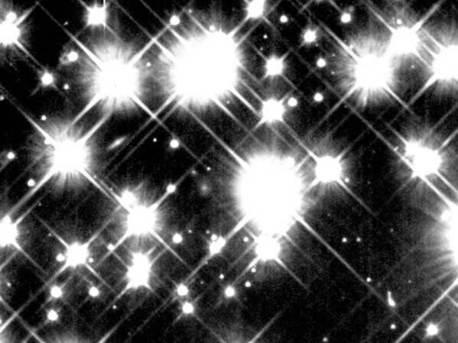White Dwarfs
A Ceres-like Dwarf Planet Swallowed by a White Dwarf Star
 © NASA |
White dwarf stars, imaged by JPL's Wide Field and Planetary Camera 2 on NASA's Hubble Space Telescope.
In a paper to be published in The Astrophysical Journal, Dufour et al. show that the star SDSS J073842.56+183509.6 is the most "polluted" white dwarf found to date, beating the previous record holder by a factor of 10. Using models of the structure and the atmosphere of this white dwarf, they show that the amount of material present at the surface of this object is about 4.3x1023 grams, close to the mass of the dwarf planet Ceres (9.4x1023 grams) which is the largest body in our solar system’s asteroid belt. Infrared photometry, taken with the Near-Infrared Imager (NIRI) on the Gemini North telescope, also revealed a large excess of infrared light that is best explained by the presence of an accretion disk around the star (Figure 1). This disk is believed to be the result of the tidal destruction of a nearby orbiting asteroid/planet feeding the surface of the white dwarf with heavy elements. Unfortunately, the mass of the disk cannot be determined at this point but it is likely to hold a similar amount of material to that present in the photosphere. Given this and the fact that an unknown amount of material has probably already sunk out of sight, it can be inferred that the object responsible for the extreme metal content observed in SDSS J0738+1835 was at least as large as Ceres, and perhaps even more massive.
Analysis of the spectroscopic data taken with MMT (Figure 2) also reveals that the chemical composition of the detected material is exceptionally similar to bulk Earth material, indicating that rocky planets similar to those in the solar system might be common. This discovery will offer a great opportunity, when higher resolution observations become available, for studying the composition of extrasolar objects with unprecedented accuracy.
source: The Gemini Observatory
White Dwarfs
A Ceres-like Dwarf Planet Swallowed by a White Dwarf Star
 © NASA |
White dwarf stars, imaged by JPL's Wide Field and Planetary Camera 2 on NASA's Hubble Space Telescope.
In a paper to be published in The Astrophysical Journal, Dufour et al. show that the star SDSS J073842.56+183509.6 is the most "polluted" white dwarf found to date, beating the previous record holder by a factor of 10. Using models of the structure and the atmosphere of this white dwarf, they show that the amount of material present at the surface of this object is about 4.3x1023 grams, close to the mass of the dwarf planet Ceres (9.4x1023 grams) which is the largest body in our solar system’s asteroid belt. Infrared photometry, taken with the Near-Infrared Imager (NIRI) on the Gemini North telescope, also revealed a large excess of infrared light that is best explained by the presence of an accretion disk around the star (Figure 1). This disk is believed to be the result of the tidal destruction of a nearby orbiting asteroid/planet feeding the surface of the white dwarf with heavy elements. Unfortunately, the mass of the disk cannot be determined at this point but it is likely to hold a similar amount of material to that present in the photosphere. Given this and the fact that an unknown amount of material has probably already sunk out of sight, it can be inferred that the object responsible for the extreme metal content observed in SDSS J0738+1835 was at least as large as Ceres, and perhaps even more massive.
Analysis of the spectroscopic data taken with MMT (Figure 2) also reveals that the chemical composition of the detected material is exceptionally similar to bulk Earth material, indicating that rocky planets similar to those in the solar system might be common. This discovery will offer a great opportunity, when higher resolution observations become available, for studying the composition of extrasolar objects with unprecedented accuracy.
source: The Gemini Observatory





